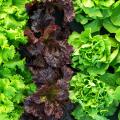Turnips-Rutabagas
Turnips and Rutabagas

Turnips are grown for both leaves (greens) and roots in the spring and fall garden. For greens, it is not necessary to thin seedlings, and there are varieties just for greens. For roots, thin seedlings to 2 to 4 inches apart.
Rutabagas are a fall crop with planting recommended in August or early September. Roots require 4 to 6 weeks longer to mature than turnip roots. Thin rutabaga seedlings to at least 6 inches apart (12 inches preferred) in the row. Rutabaga leaves can be eaten.
Hot weather causes turnips to be strong-flavored or bitter and pithy. Black spots inside the roots indicate a need for boron. Dissolve 1 level tablespoon of household borax in 3 gallons of water and apply to 100 feet of row. Use less for shorter rows.
Major problems are aphids, leaf-eating worms, and leaf spots.
Varieties
- All Top—hybrid; broadleaf turnip for tops only; dark green; 50 days.
- American Purple Top—rutabaga; 4- to 5-inch diameter; spherical; purple-red crown; pale yellow flesh; 90 days.
- Just Right—hybrid; root and top type; white root; broad, serrated leaf; 60 days; AAS 1960.
- Purple Top—old standard; root and top type; white globe root with purple crown; 57 days.
- Seven Top—leaf type; cut leaf; dark green; 45 days.
- Tokyo Cross—hybrid; root and top type; semi-globe; white root; early; 35 days; AAS 1969.
Publications
News
Vegetable producers across the Southeast are invited to the 2025 Vegetable Field Day on July 23 at the Mississippi State University station in Verona, Mississippi.
If you grow your own vegetables, you will likely see at least a few pesky insects that want to feed on your plants. Slugs are one of the pests you may be noticing now.
Did you know yellow squash is in the pumpkin family and are 95 percent water?




